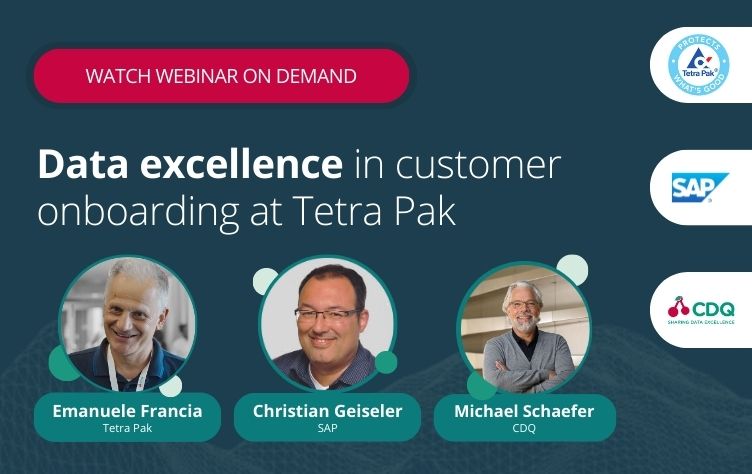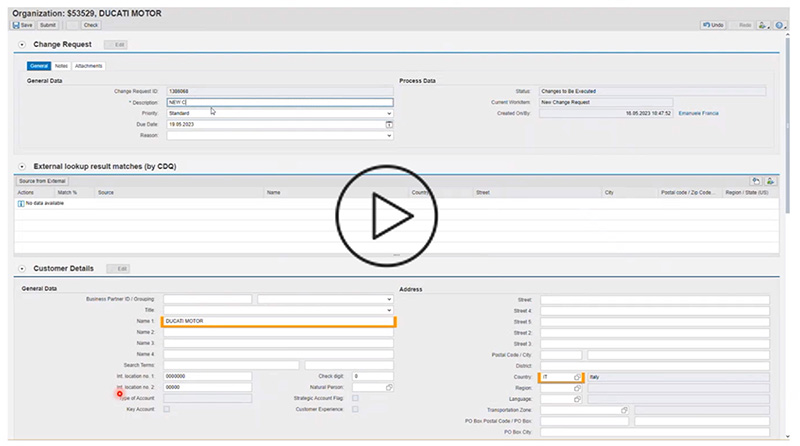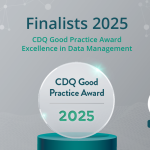Cherry picking with Tetra Pak: how data provider integration can turn the tables

Witness the added value that high-quality data can bring in combination with process-related solutions. Fueled by CDQ and SAP capabilities, Tetra Pak was able to refine their systems and processes for optimal data management.
Managing business partner data is a challenge and eventually leads to duplicates. When we talk about one system, it's typical for more than 16% of all records to be duplicates. In the heterogeneous landscape, the number easily rises to 35% or even more. Nearly 60% of records have serious quality defects, such as incorrect addresses, missing bank account information.
With all these defects, how can matching against existing business partners be successful when a new account is created? And it doesn't stop. Tens of thousands of records change every day, major and minor. How to process the volume? How to cope with this workload? At a conservative estimate, more than 20% of business partner master records are no longer up to date or correct after 12 months.
CDQ services support the governance processes in SAP and enable an error-free onboarding of customers and suppliers without duplicate generation, monitoring of data sources for changes, and furthermore, for building trust in good business partner master data.
But how exactly does it fit into SAP MDG landscape?
SAP MDG core process is the central governance which mainly involves the maintenance process workflow to proactively ensure data quality when creating new business partner or other master data records. There's a variety of quality mechanisms to ensure that only high-quality data arrives in your operational and analytical systems:
There are capabilities to address mass processing, including quality validations before activation.
There's a consolidation process with best record creation, with the capability of matching content from various sources to create a deduplicated list of best records for central usage.
And there’s an embedded data quality management, which provides analytical capabilities about the master data not managed in MDG itself: with reporting using a rule concept, with machine learning-based rule mining to support creation of data quality rules, scorecards, visualization, and capabilities to immediately launch activities like workflows to correct master data records that have failed certain quality rules.
Along with the idea of data quality management, there's the definition of quality, which mainly involves setting up the quality rules that are used for the analysis of existing data but can also be used to use the very same data quality rule in the create or change process to avoid making the same error again.
In the ongoing process of checking, analyzing data quality, aster data business partner data is provided by CDQ. This gives the possibility of a high degree of automation, so that you can onboard external data from CDQ and take all the values, attributes, address data IDs, to continue with the maintenance process.
Different MDG deployments
A native integration mechanism to CDQ as a data provider with SAP Master Data Governance Cloud Edition was launched in 2022.
You can also use CDQ APIs to build on your own configuration to MDG on S4/HANA, and the roadmap to delivering this integration capability natively, as a standard functionality in future releases of MDG on S4/HANA, is being worked out.
Tetra Pak story

Tetra Pak is a world-leading food processing and packaging solution company, with 12.1 billion of packaging materials sold annually and a presence in more than 160 countries.
Their journey of master data began in 2016 with an introduction of the concept of master data, that brough focus on its identification, ownership, and assignment to various approaches. Data types were defined, business rules developed, and a regional team was established to make the process more efficient.
In the second phase, Tetra Pak aimed to improve maintenance efficiency and introduced MDG (Master Data Governance) and SDG (Supplier Data Governance). These systems were first implemented with finance and then with material and customer data. The concept of business partners was brought to life and a global Data Management Team was built.
Transition from regional teams to a global team supported the overall master data solution. Their focus shifted towards master data automation, system automation, and data quality assessment. Emphasized shift of responsibility from maintainers to requestors, proved to be beneficial.
Why CDQ?
CDQ was introduced to ensure the uniqueness and accuracy of customer data during the migration process. Deduplication check was successfully implemented without major issues. Solution capabilities were finetuned during subsequent implementations, staggering the process across different regions.
Deep integration of CDQ capabilities into MDG workflows started in July 2022 and until November 2023 the rollout is planned to be final.
A three-fold focus:
- Integrating First-Time-Right in MDG with CDQ as source
- Integrating data validation in First-Time-Right
- Implementing data curation and validation as part of the data quality assessment using the data cleaning functionality.
The rollout started with four pilot countries. Today, already 35 countries are implemented and Tetra Pak is approaching the remaining ones.
Cherry-picking
Address curation functionality provides the local language to introduce as part of the enrichment data in the international version of SAP data. For Tetra Pak this comes in particular handy for countries like Japan and Israel because the source can provide the local language.
Data quality assessment comprises preparing the data mirror and preparing the rule execution to ensure first-time-right data.
Talking about first time right, the first step is to provide the name, the general data information on the customer and to use an external provider to get a list of potential candidates that you can select and cherry-pick. The cherry-picking means that according to the data that the provider can provide you, you can select either all the information or just some of them.
To secure the process, Tetra Pak introduced a mandatory step before change request is completed and ensures that the validation rules are running all the time.
More examples
Based on the account group type, different types of information can be populated. For example, for sold-to part we populate the identification number, while in the ship-to part, only the address and the name of the customer are mentioned.
With cherry-picking functionality you can see the list of fields which are available data from the external source that can be uniquely identified, and can be selected from the preferred list. You can do the cherry-picking and then replace the fields into the change request.
Before submitting change request, you see if the validation rule has been successfully run. If yes, you can go further. Otherwise, you can get blocked or get informed about the potential issues.
Watch the demo from Tetra Pak:

Get our e-mail!
Related blogs
The e-invoicing reality: the gateway is ready, but is your data?
Over the past decade, the EU has steadily shifted from encouraging electronic invoices to mandating them. And while the technology obviously plays an important…
How Henkel is turning master data quality into a service
Every now and then, you come across a project that makes you stop and think: “Now that’s how it should be done!” That’s exactly the case with Henkel and their…
Turning compliance challenges into manageable workflows
The world of compliance is a fast-moving, complex landscape, and for many teams, staying ahead of regulations (e.g. AMLD5) feels like an endless game of catch…






